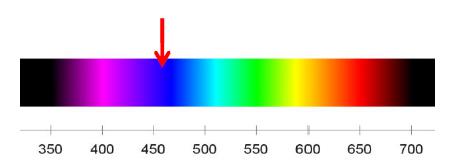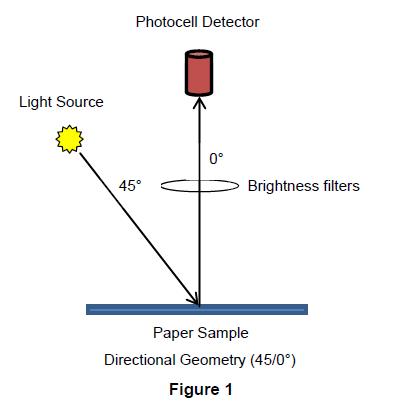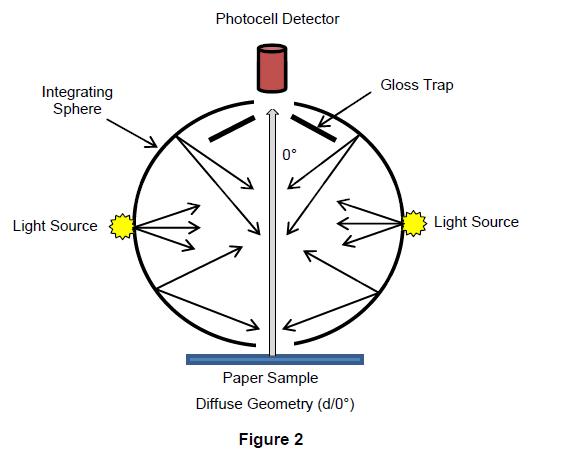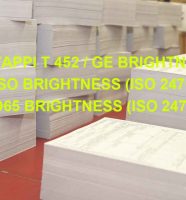Understanding paper brightness
理解纸张亮度
综述
Brightness quantifies the percentage of blue light reflected from the surface of paper as measured at a specific effective wavelength of 457 nanometers (with a half-peak bandwidth of 44 nm).1
亮度可量化从纸张表面反射的蓝光的百分比,该百分比是在457纳米的特定有效波长(半峰带宽为44 nm)下测量的。

注释1 Monitoring the photometric curve response throughout the pulp bleaching cycle shows that changes are greatest in the short wavelength area (the violet/blue region of the visible spectrum). Therefore, 457 nanometers has been determined to be an appropriate wavelength for optimal measurement of light reflection to monitor pulp and paper brightness.
在整个纸浆漂白周期中监测光度曲线响应表明,在短波长区域(可见光谱的紫色/蓝色区域)变化最大。 因此,已确定457纳米是用于最佳测量光反射以监测纸浆和纸张亮度的合适波长。
Brightness does not indicate the color or relative shade of the paper since a single number reflective value measured at 457 nm ignores all other wavelengths of light reflected across the visible spectrum. A brighter paper, therefore, reflects a greater amount of blue light than does the surface of a less bright paper.
亮度不表示纸张的颜色或相对阴影,因为在457 nm处测得的单个数字反射值会忽略可见光谱中反射的所有其他波长的光。 因此,较亮的纸张比不亮的纸张表面反射更多的蓝光。
Three different brightness measurement methodologies are used worldwide. Each of these methods will produce a different brightness number when used to measure the same paper sample. It is, therefore, important to understand basic concepts of each of the three testing methods, including photometric principles, characteristics of the illuminants, and illumination/observer—reflected light measurement geometries.
全球使用三种不同的亮度测量方法。 当用于测量同一纸样时,这些方法中的每一种都会产生不同的亮度值。 因此,重要的是要理解这三种测试方法中每一种的基本概念,包括光度学原理,光源的特性以及照明/观察者反射的光测量几何形状。
Due to differences in illuminants and illumination/reflected light measurement geometries, there are no direct correlations between brightness measurements produced by the three methods.
The three paper brightness standards are briefly described as follows.
由于光源和照明/反射光测量几何形状的差异,这三种方法产生的亮度测量之间没有直接相关性。以下简要介绍了三种纸张亮度标准。
TAPPI (T 452) / GE Brightness
TAPPI(T 452)/ GE亮度
The Technical Association of the Pulp and Paper Industry (TAPPI) has authorized method T 452 for use in determining the brightness of paper. TAPPI T 452 brightness is often referred to as GE brightness since General Electric invented one of the first paper brightness testing machines which became the industry standard for decades. The GE brightness measurement scale has been in place since the 1930s. Considering there are two TAPPI standards for brightness, we will hereafter refer to the T 452 method as GE brightness.
制浆造纸工业协会(TAPPI)已批准方法T 452用于确定纸的亮度。 TAPPI T 452亮度通常被称为GE亮度,这是因为通用电气(General Electric)发明了最早的纸张亮度测试机之一,该测试仪数十年来已成为行业标准。 自1930年代以来,GE便已建立了亮度测量模型。 考虑到有两种TAPPI亮度标准,以下我们将T 452方法称为GE亮度。
GE brightness is used for specification of paper brightness primarily in North America.
The International Commission on Illumination—also known as the CIE from its French name, the Commission Internationale de l′Eclairage, has defined the spectral power distributions of several illuminants which are divided into three categories: tungsten, daylight, and fluorescent.
When measuring GE brightness, the paper sample is illuminated with a CIE illuminant C defined light source;2 a simulated daylight illuminant containing a certain amount of U.V. energy.3 In-line “brightness” filters are also applied which modify the spectral characteristics of the reflected illuminant.
GE亮度主要在北美用于指定纸张亮度。
国际照明委员会(也从其法语名称国际照明委员会也称为CIE)定义了几种光源的光谱功率分布,这些光源分为三类:钨丝灯,日光和荧光灯。
在测量GE亮度时,用CIE光源C定义的光源对纸样进行照明; 2包含一定量U.V的模拟日光光源。 3还使用了在线“亮度”滤光片,可以改变反射光源的光谱特性。
2 CIE illuminant C is no longer a CIE standard illuminant. However, the International Commission on Illumination publishes a spectral power distribution, tristimulus values, and chromaticity coordinates for illuminant C. Illuminant C is used by many spectral and colorimetric measurement systems.
2 CIE光源C不再是CIE标准光源。 但是,国际照明委员会发布了光源C的光谱功率分布,三刺激值和色度坐标。许多光谱和比色法测量系统都使用光源C。
3 ISO 2470-2 states that the UV content of CIE illuminant C approximates levels of UV energy present in certain indoor viewing conditions—significantly less than the UV content of CIE standard illuminant D65.
3 ISO 2470-2指出,CIE光源C的紫外线含量近似于某些室内观察条件下存在的UV能量水平显著低于CIE标准光源D65的紫外线含量。
TAPPI T 452 specifies directional illumination/measurement geometry of 45° illumination, 0° observation (i.e., 45°/0°). In other words, the test instrument emits light which strikes the surface of the paper at a 45° angle of incidence. A photocell receptor is positioned at the N or 0° position, perpendicular to the paper sample. The directional illumination/reflected light measurement geometry is illustrated in figure 1.
TAPPI T 452规定了45°照明,0°观察(即45°/ 0°)的定向照明/测量几何形状。 换句话说,测试仪器发出的光以45°的入射角撞击纸张表面。 光电管接收器位于垂直于纸样的N或0°位置。 定向照明/反射光测量的几何形状如图1所示。

A focused beam of light strikes the paper sample at 45° and, after passing through a series of filters, the reflected light is received by the photocell.
聚焦的光束以45°的角度照射纸样,并且在通过一系列滤镜之后,反射的光被光电管接收。
The quantity of reflected light received by the photocell is measured and expressed based on a scale relative to the amount of light that would be reflected from a 100% reflective magnesium oxide standard. Therefore, the expressed brightness measurement mandated by the GE methodology is not an exact percentage of light actually reflected from the paper.
相对于从100%反射性氧化镁标准反射的光量的比例,测量并表示光电管接收的反射光量。 因此,GE方法要求的明示亮度测量值并不是从纸上实际反射的光的准确百分比。
There are advantages and disadvantages to the directional geometry method specified by the TAPPI T 452/GE brightness standard.4 One of the challenges of directional illumination and measurement is that the focused illumination geometry makes the system sensitive to non-uniformities in the paper. Different test results may be obtained when measuring in the machine and cross-machine directions (i.e., parallel to paper grain and across paper grain direction respectively). The industry typically measures the directional brightness of paper samples with orientation parallel to grain direction.
TAPPI T 452 / GE亮度标准规定的定向几何方法有优缺点。4定向照明和测量的挑战之一是聚焦照明几何会使系统对纸张的不均匀性敏感。 在纵向和横向上(即分别平行于纸纹和横跨纸纹方向)进行测量时,可以获得不同的测试结果。行业通常采用平行于纹理方向的方向来测量纸张样本的方向亮度。
4 Technidyne Corporation Technical Bulletin No: 101: Diffuse vs. Directional Brightness Measurement, provides an excellent overview of the advantages and disadvantages associated with the directional and diffuse measurement systems.
4Technidyne Corporation技术公告号:101:漫射与定向亮度测量,很好地概述了定向和漫射测量系统的优缺点。
ISO Brightness (ISO 2470-1)
ISO亮度
The ISO paper brightness measurement system, as defined by ISO 2470-1 and TAPPI T 525, is used for specification of paper brightness throughout Europe and in many other parts of the world.
When measuring ISO brightness, the paper sample is illuminated with a CIE illuminant C light source; a daylight illuminant containing a certain amount of U.V. energy. This is the same illuminant used by the TAPPI T452/GE paper brightness measurement system (see footnotes 2 and 3).
ISO 2470-1和TAPPI T 525定义的ISO纸张亮度测量系统用于规范整个欧洲和世界许多其他地区的纸张亮度。
在测量ISO亮度时,用CIE光源C光源照亮纸张样品。 包含一定量紫外线的日光光源能源。 这与TAPPI T452 / GE纸张亮度测量系统使用的光源相同(请参见脚注2和3)。
ISO 2470-1 specifies an illumination/reflected light measurement system which utilizes diffuse optical geometry (diffuse illumination, 0° observation; i.e., d/0°). The instrument used to measure ISO brightness illuminates the samples with light projected by two lamps into an integrating sphere. The interior wall of the sphere is coated with a highly reflective non-glossy material which allows the light to inter-reflect and illuminates the paper sample from all directions; i.e., diffusely. Photocells or diode receptors are positioned at the 0° position, perpendicular to the plane of the paper sample, and record the amount of light reflected from the paper’s surface. The computer analyzes the spectral power distribution of the reflected light and quantifies the energy response at 457 nanometers. Figure 2 illustrates the diffuse illumination/observation system.
ISO 2470-1规定了一种照明/反射光测量系统,该系统利用漫反射光学几何形状(漫射照明,0°观察;即d / 0°)。 用于测量ISO亮度的仪器用两个灯投射到积分球中的光照射样品。 球体的内壁涂有高反射率的非光泽材料,该材料可以使光线相互反射并从各个方向照亮纸质样本。 即分散地 光电管或二极管接收器位于与纸样平面垂直的0°位置,并记录从纸表面反射的光量。 计算机分析反射光的光谱功率分布,并量化457纳米处的能量响应。 图2示出了漫射照明/观察系统。

Diffuse measurement geometry integrates the light reflected across non-uniformities of the sample and averages the effects of reflective differences due to paper directionality. Therefore, ISO brightness measurements are less sensitive to paper surface and directional orientation irregularities.
Unlike the TAPPI T 452/GE method, the ISO brightness measurement system quantifies the actual percentage of light reflected from the sample at 457 nm rather than relating measurements to a scale correlated to the percentage of light reflected by an external standard.
The ISO brightness methodology typically produces a higher brightness number than the TAPPI T 452/GE method when measuring the same paper sample due to slightly greater fluorescence stimulation, the illumination/light measurement geometry, and the brightness scales used.
漫射测量几何形状将跨样品不均匀性反射的光进行积分,并对由于纸张方向性导致的反射差异的影响求平均。 因此,ISO亮度测量对纸张表面和方向取向的不规则性较不敏感。 与TAPPI T 452 / GE方法不同,ISO亮度测量系统对从样品在457 nm处反射的光的实际百分比进行量化,而不是将测量值与与外标反射的光的百分比相关的比例相关。
当测量相同的纸张样本时,由于稍稍更大的荧光刺激,照明/光测量几何形状和所使用的亮度标度,ISO亮度方法通常会产生比TAPPI T 452 / GE方法更高的亮度值。
D65 Brightness (ISO 2470-2)
D65亮度
The D65 brightness measurement system (ISO 2470-2) is essentially the same as the previously described ISO system (ISO 2470-1) with the exception of the specified illuminant.
D65 brightness uses the CIE standard illuminant D65, an outdoor (average north sky) daylight illuminant containing a significantly greater amount of UV energy than CIE illuminant C (as specified for ISO brightness measurement). Therefore, the additional UV energy emitted by the D65 standard illuminant will produce a greater fluorescence response when the paper contains optical brightening agents. Consequently, D65 brightness measurements will be significantly higher (when paper contains optical brightening agents) than those produced by the TAPPI T 452/GE or the ISO brightness methods which specify an illuminant with less UV content.
The following provides a comparison of key elements for each brightness measurement standard:
Standard
除了指定的光源外,D65亮度测量系统(ISO 2470-2)与先前描述的ISO系统(ISO 2470-1)基本相同。
D65亮度使用CIE标准光源D65,这是一种室外(北方室外平均)日光光源,其紫外线能量比CIE光源C(ISO亮度测量所指定的)要大得多。 因此,当纸张包含荧光增白剂时,D65标准光源发出的额外紫外线能量将产生更大的荧光响应。 因此,D65亮度测量值(当纸张包含光学增亮剂时)将比TAPPI T 452 / GE或ISO亮度测量法(指定紫外线含量较低的光源)产生的测量值高得多。
下面提供了每种亮度测量标准的关键要素的比较:
Standard | Illumination/Viewing Geometry | Illuminant |
TAPPI T 452 / GE Brightness | Directional (45°/0°) | CIE illuminant C (filtered response) |
ISO Brightness (ISO 2470-1) | Diffuse (d/0°) | CIE illuminant C |
D65 Brightness (ISO 2470-2) | Diffuse (d/0°) | CIE standard illuminant D65 |
If a paper contains optical brightening agents, the GE brightness methodology will produce the lowest brightness number while D65 brightness will produce the highest.
Note regarding fluorescence and brightness measurements in excess of 100%
关于荧光和亮度测量超过100%的注意事项
In response to the design community and the graphic arts industry’s demand for brighter “blue white” papers, fine paper manufacturers commonly add chemical compounds called optical brightening agents or fluorescent whitening agents (OBAs/FWAs) to commercial printing papers. These chemicals have the unique ability to absorb ultraviolet radiation and then transform and re-emit invisible UV wavelengths as high energy photons of light in the violet/blue area of the visible spectrum—a phenomenon called fluorescence. Invisible UV wavelengths such as contained in sunlight, ISO 3664:2009 standard lighting, and, to varying degrees in many artificial light sources, are therefore absorbed by optical brightening agents in fine printing papers and transformed into wavelengths of energy perceptible to human viewing. This transformed UV energy becomes “visible” light radiating from the paper’s surface.
When illuminated by a light source containing a significant amount of U.V. energy, the energy transference process (from invisible to visible wavelengths) is activated and an optical brightener enhanced paper may actually reflect more total light than it receives from the light source (i.e., visible light reflected from the light source plus re-emitted “blue” light transferred from the invisible realm of the electromagnetic spectrum).
为了响应设计界和制图行业对更明亮的“蓝白色”纸的需求,高级纸制造商通常在商业印刷纸中添加称为光学增白剂或荧光增白剂(OBA / FWA)的化合物。 这些化学物质具有独特的吸收紫外线的能力,然后将可见光谱的紫色/蓝色区域中的高能光子转化为高能光子,然后将不可见的UV波长转换并重新发射,这种现象称为荧光。 因此,可见光,ISO 3664:2009标准照明中所包含的不可见紫外线波长,以及许多人造光源中的不可见紫外线波长,在高级打印纸中被荧光增白剂吸收,并转换为人类可见的能量波长。 转换后的UV能量变成从纸张表面辐射的“可见”光。 当被包含大量紫外线的光源照亮时 能量,将激活能量转移过程(从不可见波长到可见波长),并且荧光增白剂增强的纸张实际反射的总光量可能比其从光源接收到的总光多(即,从光源反射的可见光加上重新发出的“蓝色”光)。 从电磁频谱的隐形领域转移来的光)。
Since paper brightness is measured in the blue area of the visible spectrum (457 nm), the very region where the process of fluorescence redirects UV energy to become visible light, illuminants with high UV energy content (e.g., D65) can produce brightness measurements in excess of 100%.
Fluorescence may be quantified with both directional and diffuse measurement systems. Measurements are made with and without the use of a UV-cut filter. A fluorescence value is then calculated from the mathematical difference between the UV included and UV excluded measurements. Note that the measurement system must utilize a controlled, spectrally defined illuminant since the spectral power distribution characteristics and UV energy content of the light source will significantly affect the balance of reflected light and the degree of fluorescence.
由于纸张的亮度是在可见光谱(457 nm)的蓝色区域中测量的,该区域正是荧光过程将UV能量重定向到可见光的区域,因此具有高UV能量含量的光源(例如D65)可以超过100%。
荧光可以通过定向和漫射测量系统进行定量。在使用和不使用紫外线截止滤光片进行测量。 然后,根据包含的紫外线测量值和排除的紫外线测量值之间的数学差异计算荧光值。 注意,由于光源的光谱功率分布特性和紫外线能量含量会显着影响反射光的平衡和荧光度,因此测量系统必须使用受控的、光谱定义的光源。
Comparative brightness measurements
比较亮度测量
As previously pointed out, each of these brightness measurement methods will produce a different brightness number when used to measure the same paper sample.
Due to slight modification of the illuminant, measurement geometries, and the GE standard brightness scale, TAPPI T 452/GE brightness will yield the lowest brightness number of the three methods. TAPPI T 452/GE brightness numbers will rarely exceed 100. When measuring the same paper sample, ISO brightness numbers will be slightly higher than those produced by the GE brightness method. The D65 brightness measurement methodology will return the highest readings—often in excess of 100% for papers containing fluorescent components. This is due to the high UV energy content of the CIE standard illuminant D65.
The three methods may produce similar brightness numbers when measuring a common paper with low fluorescence. However, as fluorescence increases, the measurements produced by the three different methods will become progressively dissimilar.
如前所述,这些亮度测量方法中的每一种在测量同一纸样时都会产生不同的亮度值。
由于对光源,测量几何形状和GE标准亮度标度进行了轻微修改,因此TAPPI T 452 / GE亮度将是三种方法中最低的亮度值。TAPPI T 452 / GE亮度值很少会超过100。在测量同一纸张样品时,ISO亮度值将比GE亮度法产生的亮度值稍高。D65亮度测量方法将返回最高读数-对于包含荧光成分的纸张,其读数通常超过100%。 这是由于CIE标准光源D65的紫外线能量较高。
在测量低荧光的普通纸时,这三种方法可能会产生相似的亮度值。 但是,随着荧光的增加,通过三种不同方法产生的测量结果将逐渐变得不同。
References
参考文献:
1. TAPPI T 452 om-08; Brightness of pulp, paper, and paperboard.
2. ISO 2470-1, Second edition 2016-09-15; Paper, board and pulps—Measurement of diffuse blue reflectance factor; Part 1: Indoor daylight conditions (ISO brightness).
3. ISO 2470-2, First edition 2008-11-01; Paper, board and pulps—Measurement of diffuse blue reflectance factor; Part 2: Outdoor daylight conditions (D65 brightness).

